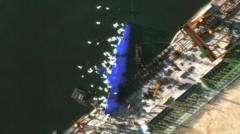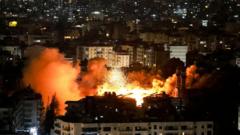North Korea has successfully refloated a 5,000-tonne destroyer, two weeks after it capsized during a botched launch attempt. The country’s state news agency, KCNA, announced that the vessel was safely re-launched and moored at a pier ahead of a key meeting led by Kim Jong Un. Observations from satellite images confirmed the warship's upright position in the harbor. The recovery involved a meticulous manual process, which included the use of tethers and barrage balloons. Kim criticized the failed launch as a severe blow to the nation's dignity and punished several officials involved in the mishap. Analysts suggest that this incident may motivate the regime to double down on military advancements, especially as it seeks to enhance its naval capabilities ahead of previously announced deployments.
North Korea Successfully Refloats Warship After Launch Mishap

North Korea Successfully Refloats Warship After Launch Mishap
North Korea has reportedly restored a warship that capsized during a launch attempt, signifying a determined effort to regain military stability and public image.
North Korea has reportedly refloated a warship about two weeks after it capsized during a launch attempt, in an incident that drew harsh criticism from the country's leader Kim Jong Un. State-run news agency KCNA reported on Friday that the warship had "safely entered the water vertically" and had then been "moored at the pier." It is expected to be fully repaired before a key meeting led by Kim which top officials in the one-party state attend, KCNA said.
The 5,000-tonne destroyer can be seen upright at the pier and then about three hours later, "floating in the harbour" in satellite images published by specialist news sites 38 North and NK News. The effort to right the ship, which had happened on Thursday, was a manual process, researchers at 38 North said, noting that satellite imaging showed workers on the quay pulling tethers and using barrage balloons to bring the vessel back to balance. Some of the balloons appeared to still be attached to the vessel, they added.
Kim, who witnessed the warship tipping over during the failed launch, had criticized the incident as a "criminal act" that "severely damaged the [country's] dignity and pride." It was the result of "absolute carelessness, irresponsibility and unscientific empiricism," he added. At least four officials including Ri Hyong-son, the deputy director of the ruling Workers' Party's Munitions Industry Department, have been arrested over the incident. Mr. Ri is part of the party's Central Military Commission, which commands the Korean People's Army and is responsible for developing and implementing North Korea's military policies.
It is not clear what punishment the officials might face, but the secretive dictatorship has been known to sentence officials it finds guilty of wrongdoing to forced labour and even death. Some analysts saw Kim's swift and severe response to the earlier failed launch as a signal that Pyongyang would continue to advance its military capabilities. The regime is "deeply invested in the image of a rising military power" and the failure may harden their resolve to push that forward, says Jihoon Yu, a research fellow at the Korea Institute for Defense Analyses.
Kim's "unusually severe" response to the failure is aimed at protecting the leader's image and reasserting his authority, he adds. Michael Madden, a North Korea expert from the Stimson Center in Washington, sees Kim's response as a sign of the "high priority" his regime is putting into developing warships. Just weeks before the botched launch, Pyongyang had unveiled a similar warship in another part of the country. Kim called that warship a "breakthrough" in modernizing North Korea's navy and said it would be deployed early next year.
The 5,000-tonne destroyer can be seen upright at the pier and then about three hours later, "floating in the harbour" in satellite images published by specialist news sites 38 North and NK News. The effort to right the ship, which had happened on Thursday, was a manual process, researchers at 38 North said, noting that satellite imaging showed workers on the quay pulling tethers and using barrage balloons to bring the vessel back to balance. Some of the balloons appeared to still be attached to the vessel, they added.
Kim, who witnessed the warship tipping over during the failed launch, had criticized the incident as a "criminal act" that "severely damaged the [country's] dignity and pride." It was the result of "absolute carelessness, irresponsibility and unscientific empiricism," he added. At least four officials including Ri Hyong-son, the deputy director of the ruling Workers' Party's Munitions Industry Department, have been arrested over the incident. Mr. Ri is part of the party's Central Military Commission, which commands the Korean People's Army and is responsible for developing and implementing North Korea's military policies.
It is not clear what punishment the officials might face, but the secretive dictatorship has been known to sentence officials it finds guilty of wrongdoing to forced labour and even death. Some analysts saw Kim's swift and severe response to the earlier failed launch as a signal that Pyongyang would continue to advance its military capabilities. The regime is "deeply invested in the image of a rising military power" and the failure may harden their resolve to push that forward, says Jihoon Yu, a research fellow at the Korea Institute for Defense Analyses.
Kim's "unusually severe" response to the failure is aimed at protecting the leader's image and reasserting his authority, he adds. Michael Madden, a North Korea expert from the Stimson Center in Washington, sees Kim's response as a sign of the "high priority" his regime is putting into developing warships. Just weeks before the botched launch, Pyongyang had unveiled a similar warship in another part of the country. Kim called that warship a "breakthrough" in modernizing North Korea's navy and said it would be deployed early next year.





















